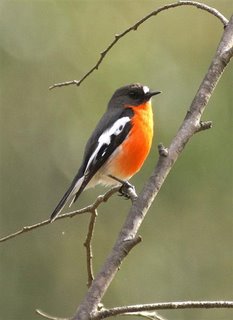 I made a brief visit to the Wielangta Forest Reserve yesterday. As usual I stopped at the Southern end of the Sandspit Walk. As I walked back to my car, two Police vehicles arrived--didn't think I looked that threatening! But this is no laughing matter. Over the last weekend, I believe, one of the three huts provided for visitors, was burnt down, and the Police Forensics were investigating the remains. I have noted in recent weeks that several of the information signs have been vandalised too--burnt in fact, others defaced. I'm afraid that misuse and vandalism at many reserves, is all too common.
I made a brief visit to the Wielangta Forest Reserve yesterday. As usual I stopped at the Southern end of the Sandspit Walk. As I walked back to my car, two Police vehicles arrived--didn't think I looked that threatening! But this is no laughing matter. Over the last weekend, I believe, one of the three huts provided for visitors, was burnt down, and the Police Forensics were investigating the remains. I have noted in recent weeks that several of the information signs have been vandalised too--burnt in fact, others defaced. I'm afraid that misuse and vandalism at many reserves, is all too common.Perhaps it was appropriate that the first birds I came upon at this site was a pair of Flame Robin (male pictured). This particular area is always worth a stop, it seems something
 of a crossroads, with birds usually associated with both wet and drier areas appearing together. Also present were a number of both Golden and Olive Whistler, Pink Robin, Scrubtit, Grey Fantail, Grey Shrike-thrush, Crescent Honeyeater, to name a few. Of special interest was a solitary Satin Flycatcher, the first I've seen this Spring, calling from high in the tree canopy.
of a crossroads, with birds usually associated with both wet and drier areas appearing together. Also present were a number of both Golden and Olive Whistler, Pink Robin, Scrubtit, Grey Fantail, Grey Shrike-thrush, Crescent Honeyeater, to name a few. Of special interest was a solitary Satin Flycatcher, the first I've seen this Spring, calling from high in the tree canopy.
1 comment:
Its particularly disappointing to hear stories like this. When did it become acceptable to damage or destroy public property? And perhaps the bigger question is why is the community not showing their disapproval more and demanding something be done?
Its an irony in a state known outside Australia for its World Heritage listed areas and natural beauty -- which in turn helps drive tourism that keeps many families fed -- that the community appears to react little more to this than they may to swat a mosquito...a minor annoyance.
Why is there not public outcry and a demand for action? Is it laws, or culturals mindsets that need to change to make this behaviour seen as shameful? Money would help policing of reserves but a cultural shift would probably protect these areas so much more.
In the US, I am often surprised [read: pleased] how little vandalism occurs even in areas where it could easily be done without being seen or caught. For whatever reason, there seems to be a different level of respect for the preserves here than there is in Tasmania [I'm not applauding the destruction of the vast percentage of natural habitat in the US - just the condition of the preserves & state parks!].
Post a Comment